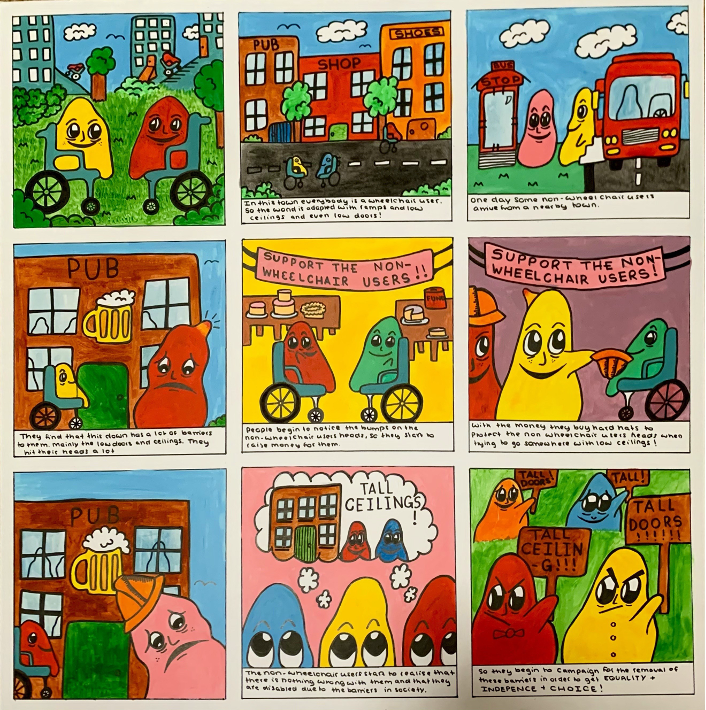Accessibility Issues: turning the tables
My creative piece is inspired by a patient I met during an online placement in general practice. Tom* had previously had extensive surgery with complications and now has a colostomy bag. What really inspired me was his description of how covid-19 has had a massive impact on his life. Tom explained how due to the closure of many public toilets it is very difficult for him to spend much time out without having to go home to change the colostomy bag, which needs to be changed 2-3 times a day. Even without additional public toilets being closed, Tom mentioned how the toilets needed a specific layout with hooks and preferably a surface for him to lay out all of his equipment. I had never really thought about how something like public toilet closure, something that was just a small inconvenience for me, could stop someone else being able to live their life. This got me thinking about the way our society is set up how we have created barriers allowing everyday parts of life, in this case spending longer periods of time away from home, simply impossible for some individuals.
I decided to display my piece in the form of a storyboard as an engaging way to tell the story of the social disability model. I used bright coloured paint and thick black lines to give it a children’s story book appearance. The storyboard follows a narrative in which the world is adapted to wheel-chair users. Since everyone is in wheelchairs there is no need for higher ceilings and so all doors and ceilings are very low. When a train of non-wheel-chair users arrive, they find it very difficult to do everyday tasks due to the disabling low ceilings. Eventually money is raised to invest in hard hats for them, however, they still have more barriers to many aspects of life compared to the wheelchair users. Eventually they realise that they aren’t the problem, and it is effectively the world disabling them and so they begin to campaign for higher ceilings. I thought it was an interesting approach to swap the roles of individuals, as it is usually wheelchair users facing many barriers in society and I thought this might make people identify with it more and understand how it is not the person, but the society we have designed that causes disability.
I think I learnt about my own lack of knowledge and naivety as I didn’t realise how difficult the structure of our society has made general life for many people with medical conditions or disabilities. I also think that by speaking to Tom I became aware of how privileged I am, something that I have previously taken for granted. Throughout this project I have gained a new perspective of how if we truly want equality – then we need to start by breaking down these barriers to offer people with disabilities or medical conditions that have an impact on everyday life, more independence, choice and control.
*Details and name changed to protect confidentiality
Highly Recommended for the Year One, Effective Consulting Creative Prize, 2021

Very thought provoking and great artwork
I found this piece of art very thought-provoking and inspiring. It lays out an important issue in our society in a simple and easily understandable format, showing the effect that our society has on marginalised people. So often, it is easy to ignore or not realise that the way our world is set out is not compatible for so many poeple, and often the best way to truly realise this is by imagining life from the perspective of those who are marginalised by society, to truly understand the challenges they face. Obviously this applies to disability, but this same concept can also be applied to so many other social issues. This piece of artwork goes a long way to showing that supporting others and accepting them for who they are is key to making our society better and more inclusive for everyone.
• Highlight the influence of privilege: addresses the naivety of much of society regarding the difficulties many disabled patients have. Many disabled patients feel it isn’t their physical impairment which prevents them from normal day to day life, but instead the lack of awareness by society to change accessibility. The world needs to adopt a new way of living which is more accessible for all; the option of doing it so non-disabled patients in the cartoon felt the restrictions by society I found to be particularly interesting and clever, as by doing so it highlight the restricted viewpoints of many patients
Veil of ignorance – concept of disability formed by not the disabled and only is now with the social model of disability that this is being challenged
• Childhood cartoon piece – demonstrates that this is how the concept of disability should be challenged; from a young age, in order to encourage greater equality of treatment and accessibility
Same concepts should be applied to many other social issues, of supporting others and accepting them to make such more inclusive, and may be therefore easier to change/have greater influence over own health behaviours